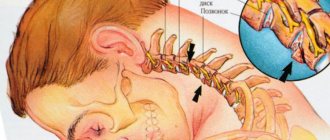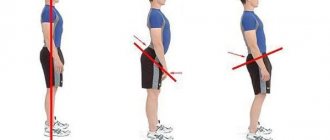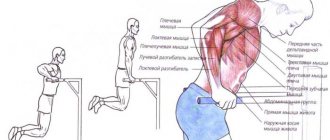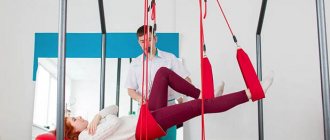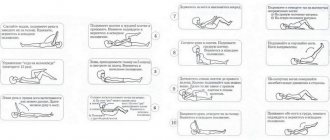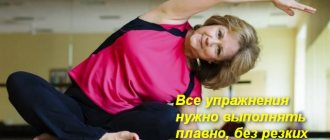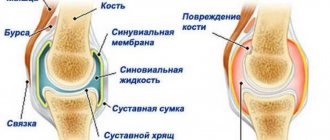Among the training devices for physical therapy, the gymnastic ball, or fitball, is becoming increasingly popular. The simulator is used both to maintain muscle tone and for rehabilitation after injuries, for the prevention and treatment of diseases of the back and spine. They will teach you how to properly perform exercise therapy with a fitball through video lessons and sessions with a personal trainer, as well as basic knowledge about such training.
Expert advice: how to choose a fitball for training?
In order for exercises on the ball to bring maximum benefit, you need to pay special attention to its choice. When choosing, it is necessary to take into account the height and age of the person who will be exercising.
First of all, this concerns its diameter:
- children 5 – 10 years old – 55 cm;
- people with a height of 150 to 170 cm – 65 cm;
- people with height from 170 to 190 cm – 75 cm;
- whose height is over 190 cm - 85 cm.
There are several types of balls:
- orthopedic – designed for pregnant women, equipped with special handles for convenience;
- Bouncing ball - created for babies. Helps relieve muscle hypertonicity, strengthen the musculoskeletal system, start the work of the abdominal organs, and calm the emotional state of the baby.
- for fitness - can be smooth or ribbed, equipped with safety brackets.
This seemingly simple sports equipment can restore flexibility and health to the spine. Muscle elasticity is restored, pain in the back area disappears, etc.
Systematic exercises on a fitball will help you regain your slim figure. Special exercises on the ball are necessary for women after childbirth. Fitball is a safe and gentle way to lose weight. It can restore lightness and health to the body and the body as a whole.
For the spine, ball exercises are the best option for maintaining its health and treating musculoskeletal diseases. In addition to functionality, the fitball has a high degree of strength and reliability, so it is absolutely safe for the practitioner.
What types of fitballs are there?
There are several types of elastic gymnastic balls:
- Balls with handles (“horns”) to maintain balance. Special handles help prevent falling from the machine. These exercise balls are more suitable for children and the elderly.
- Regular smooth fitballs of round shape. The most popular option for exercise therapy.
- Balls with soft spikes. They do not slip on the floor, and at the same time act as sports equipment and a massager.
- Large oval balls. They have increased stability; their surface can be smooth or rough (with spikes for massage).
When attending organized classes, a physical therapy doctor or fitness trainer will help you choose a suitable ball. The choice of ball depends not only on the shape and additional functions. The size of the fitball is of great importance for the comfort and benefits of training. It must match the height of the person training.
size table
| Human height (in cm) | more than 180 | 170-180 | 160-170 | 150-160 | up to 150 |
| Ball diameter (in cm) | 85-95 | 65-75 | 65 | 55 | 45 |
Note: A ball that is too large will not allow you to rest your full foot on the floor, which will result in an incorrect load on the muscles.
Indications and contraindications for fitball exercises
For hernia
Among the indications for fitball classes for children and adults, I can note intervertebral hernias in various sections, including the collar area, thoracic and lumbar sections. A properly selected program helps relieve pinching, spasm of muscle fibers along the spine and bring them into a healthy tone. I strongly do not recommend such activity at the stage of exacerbation of inflammatory processes.
For scoliosis and curvatures
A special fitball complex is very effective, especially if you have a history of acquired and congenital scoliosis, or a certain stage of spinal curvature. With a competent approach, the vertebrae come to the desired position and are fixed in it at the muscular-ligamentous level. In fact, this is one way to avoid wearing corsets and a good addition to manual therapy.
Speaking about general contraindications, I note that such loads can be dangerous for women in the first trimester of pregnancy and with its problematic course. This activity is also contraindicated in case of isthmic-cervical insufficiency and increased uterine tone. Therefore, before you include it in your complex without the supervision of a fitness trainer, you must consult a doctor.
Complications and consequences
Back exercises with a fitball should be performed with extreme caution. This is especially true for people with a vertebral hernia. It is recommended to monitor your own feelings and stop performing at the slightest discomfort. As a rule, there are no complications with the right approach to gymnastics. However, if you suddenly roll off the ball, you can get injured.
For beginners, it is advisable to have someone nearby who can protect them from falling. It is also highly undesirable to perform the complex during an exacerbation of any disease, especially in the presence of elevated temperature.
Indications and possible limitations
If the exercises are chosen correctly, they stimulate activity and develop reflexes. Exercises with fitball bring only positive results and emotions.
They contribute to:
- Increasing the tone of the nervous system.
- Strengthening the back muscles (and not only).
- Maintaining normal heart function.
- Normalization of the vestibular apparatus.
- Elimination of colic of any nature.
- Developing proper breathing.
Despite many positive factors, there are also contraindications. They should be known and taken into account. Without consulting a doctor, it is prohibited to exercise in the early stages of pregnancy, with heart disease and the presence of a hernia in the spine.
Insurance and safety issues
The ball is a round thing, it rolls on the floor. Accordingly, you can fall from it. For some, this fall will be just a funny event, but for others it will be a reason to go to the doctor.
Therefore, for elderly people and those who are not confident in themselves, it is better to use insurance. Anyone can insure. Just ask him to lightly hold your feet, for example.
The fitball relieves stress from your back. This is a huge plus of working on your back with a hernia. Since the load is removed, the pain syndrome is also relieved.
With a hernia, even hyperextension can lead to pain of varying degrees. On a fitball this is not felt so acutely.
Back care tips
If you have once encountered pain in your back, this should serve as some kind of signal for you to change your lifestyle. It is necessary to get rid of bad habits that negatively affect the body, in particular the lower back. You should start by following basic rules that will help change your life for the better.
Prevention of back pain, first of all, involves the following recommendations:
- you need to lift all the weights correctly - first sit down yourself, and then, firmly grasping the object, straighten your legs and stand with it. This rule applies to all types of weights;
- if you need to carry something heavy in bags, then try to distribute the weight evenly among the bags. With an equal distribution of weight on both hands, the likelihood of injuring your back is reduced;
- When washing your hair in the bathroom on straight legs, bending over is strictly not recommended. First, bend your knees slightly and then bend over;
- Try to always sleep on a hard mattress. This will provide the spine with proper rest at night, since it has been in a tense state throughout the day;
There are certain situations in which sports are contraindicated, even for preventive purposes. First of all, we are talking about serious problems with the spine or severe pain in the lumbar region. It is also not recommended to do any exercise after recent surgery. But your attending physician will definitely inform you about this.
Who should not play with the ball?
Exercises on a fitball can be both incredibly beneficial and harmful. Therefore, be sure to read the possible contraindications:
- Pregnancy with complications;
- Serious spinal injuries;
- Recent abdominal surgery;
- Increased body temperature;
- Skin diseases;
- Exacerbation of chronic diseases of internal organs;
- Pathologies of the heart and blood vessels;
- Increased uterine tone.
It is also necessary to perform exercises with caution when there is a hernia of the spine, and in no case should be done during an exacerbation. It is best to choose an individual complex together with a physical therapy doctor.
That's all for me. Buy and inflate fitballs and go ahead, wake up your sleeping muscles. And the above exercises will undoubtedly help you strengthen your back and reduce the occurrence of pain in the spine. They will also remove excess fat deposits. It just takes a little bit of regularity and perseverance!
Have a healthy back! See you!
Main characteristics
When choosing and purchasing an elastic ball, you need to study its features and characteristics. The following indicators require the most attention:
- sufficient elasticity. When you lightly press the surface, the ball should spring back;
- strength;
- Smooth surface. If the ball is of high quality, the seams should not be visible;
- possessing antistatic properties;
- tightly inserted nipple that reliably holds air inside;
- no unpleasant odor from the ball.
In order to purchase gymnastic equipment that suits your diameter, you need to know your exact height. The values of this indicator are divided into four groups: up to 155 cm, from 155 to 169 cm, from 170 to 185 cm, and finally, 186 cm and above; for each of the groups, the ball diameter is 45, 55, 65, respectively. cm, and more than 75 cm.
To understand that the model you have chosen will fit perfectly with your build, you can take the following position: sit on top of the ball, and in this position make sure that the angles between the thigh and the straightened torso, lower leg and foot placed on the floor are straight, that is, approximately 90 degrees .
This equipment should be used on a flat, smooth surface, this will avoid accidental mechanical damage. If you were unable to avoid a puncture, do not rush to go to the store for a new ball; there is always the opportunity to repair the damage. Often the product comes with glue, which can be used to solve this problem.
The maximum weight load allowed on a fitball is indicated in the description of the technical characteristics of the model. Typically, quality products can withstand the weight of even the largest athlete. The maximum load in most models is from 200 to 300 kg.
We advise you to study – Orthopedic belt for the back
Exercises for curvature of the spine
The following list is highly effective exercises with a ball, which are aimed at strengthening the muscle corset:
- Lie on the floor with your stomach down, turning your palms down and resting your feet on the ball. The palms need to be alternately moved back and forth, thereby imitating walking on your hands. Duration – 7 – 10 minutes.
- While in the same position, do 5 to 10 push-ups.
- Lie on the apparatus with your back, placing your feet on the floor, raise your arms above your head and twist to the abdominal area.
Top 10 exercises on a fitball for the back and spine
1. Stabilize your core and improve your balance.
Start a set of back ball exercises with simple movements.
- From a straight body position, lift your pelvis and lock your heels in the center of the ball.
- Squeeze your buttocks and stomach as much as possible. Maintain body balance with your hands on the floor and shoulder blades.
- Pause at the climax and lower yourself to the floor.
Perform 15 lifts and make the exercise more difficult by alternately raising your legs vertically at the top.
Static hyperextension
- Place your stomach on the ball, toes on the floor, and extend your left arm forward and up.
- Point your right hand down closer to your thigh.
- Raise the thumbs of both limbs towards the ceiling.
- Align your body into a string.
- Stay in a static position for 20 seconds and switch hands.
Repeat the practice 8-10 times x 2.
3. Static hyperextension: option two
- Stay in the same position, with your toes on the floor, your heels on the wall, and the middle part of your torso aligned horizontally with the floor.
- Close your hands at the back of your head, lift your chin and tense your core muscles.
- Hold this position as long as you can and exhale.
Hyperextension on a fitball
- In a face-down position, with your stomach on a fitness ball, close your hands at the back of your head, lower your lower body, and rest your toes on the floor.
- From this position, lift your shoulders and crown up until you form a straight line with your lower limbs.
Having mastered the technique, pick up a weight. Start with 8x2, then gradually work your way up to 15x3.
5. Exercises on a fitball for the back and spine
- Sit near the ball with your legs bent, leaning your elbows on the elastic surface with your shoulder blades.
- Twisting your pelvis and tailbone, round your shoulder blades, and smoothly rise upward, maintaining a given angle in your knee joints.
- Straighten your back, sequentially placing vertebrae by vertebrae on the gymnastic ball. Move your legs following the movements of your upper body. At the climax, turn your straight arms into a V or spread them horizontally.
Exercises on a fitball to strengthen the back muscles with dumbbells
Exercise on a fitball to strengthen your back muscles minimizes the risk of injury during strength training.
- Press your thighs into the sphere, your toes into the floor, and hold the dumbbells in your palms.
- Raise your neck, straighten your back, avoiding arching in your lower back.
- Extend your upper limbs at shoulder level.
- Twisting your spine to the left, lift your right shoulder up, while leaving your left arm motionless.
- Count to 7 and repeat everything from the beginning.
Do 10 repetitions for each side. As you get used to it, increase the weight.
Rifles
This is one of the popular back exercises with a ball.
- Lie on your shoulder blades, throw your feet over the sphere and rest your heels in the middle.
- Raise your pelvis and use your thigh muscles to roll it towards you.
- Maintain balance with your arms extended parallel to your body.
- Align your body, pause briefly and perform a series of reverse movements.
Walk on your hands
- Rest your hips on the gymnastic ball and place your palms on the floor.
- Step forward with your hands, then move your body until the sphere is under your knees.
- Line up. To maintain balance, keep your hands under your shoulders and your neck relaxed.
- Using muscle tension in your abdomen and thighs, roll the ball back and lift your legs into the fitball.
- Now gently return it under your knees.
Turns
- Secure your shoulder blades onto the ball in a lying position.
- Keep your legs bent at right angles and your palms crossed in front of your chest.
- Stabilize your body and perform a series of body turns left and right.
Exercise for the back and rear delts on a fitball
- Lie face down on an exercise ball.
- Place your forearms on top of each other in front of your chest, shifting your body weight to your hip joints.
- Stretch out, stretch your limbs to the side, pointing your thumbs towards the ceiling.
- Smoothly rotate your wrists in the opposite direction so that your outstretched fingers point downwards, and hold.
- Performing reverse movements, return to IP.
Make at least 12 x 2.
At the end of your workout, remember to relax. Take a pose lying with your back down, stretch your arms back, stay in this position on the ball for 30 seconds.
How to exercise with osteochondrosis and scoliosis?
A doctor should select a set of therapeutic exercises for the back with a fitness ball, especially if there is a serious pathology of the spine: some movements cannot be performed with one or another type of curvature. It is best to start training in a group under the guidance of a trainer to learn the technique of each exercise.
At home, you can perform a set of three simple exercises by including it in your morning exercises or performing them instead. Start with a stretch: sit on the ball, round your back, hug yourself under your knees. Stretch your shoulder blades up, neck, shoulders and back relaxed. Exhaling, bend towards your feet and freeze for half a minute. Repeat three to four times, trying to bend lower and lower.
- Lie on your stomach over the ball, with your arms and legs touching the floor. Lift your limbs one at a time: arm, leg, both arms, both legs.
- Rifles. Lie with your stomach over the ball and move your hands, moving first forward until only your hips remain on the machine, and then back so that your feet are on the floor and the fitball is under your chest. Perform 3-5 repetitions, turn onto your back and roll back and forth in the same way as you did on your stomach.
Finish the session with relaxation: remaining on the floor, place your straightened legs with your calves on the ball. Relax completely and lie there for 10–15 minutes. This pose helps relieve painful spasms when nerve roots are pinched in the lower back, and relieves tension from the back and abdominal muscles.
Exercises with a fitball for scoliosis give good results when performed regularly. Posture improves and the curvature of the spine is gradually corrected. First exercise: starting position - support on your hands, your legs rest on the fitball with your shins. It is necessary to move the hands smoothly and alternately, imitating walking.
Posture exercise with fitball performed slowly
Next, you need to lie with your back on the fitball, put your hands behind your head and, if possible, rest them on the floor, like your legs. You should remain in this position for at least 30 seconds. Then take a short rest and repeat the action.
Exercise against pinching will straighten all vertebrae
The third exercise is performed on the floor. You need to lie on your back and rest your feet on the fitball. Next, you should raise your body, holding in this position. The body should form a straight line with the legs. The arms are extended forward and the gaze is fixed on the ceiling. 15 reps total. This exercise perfectly trains all the back muscles.
Exercise for scoliosis with a fitball trains all back muscles
Basic classification and types of gymnastics
Gymnastics is more of a collective concept. Types of gymnastics in accordance with the main classification: recreational, sports, applied.
Acrobatic gymnastics
Acrobatic gymnastics is a non-Olympic sport. It involves performing a set of exercises while maintaining balance and rotation of the body with or without support. The basis of gymnastic exercises is mastery of the body and good muscle development.
Exercises are divided into:
- balance – demonstrates strength, agility, flexibility, balance;
- dynamic (tempo) - demonstrate flight with throwing, pushing, catching;
- combined (mixed) – contains elements of balance and dynamic exercises.
Judges evaluate:
- complexity of the composition;
- artistry;
- performance technique.
Acrobatic gymnastics is included in the family of different types that are part of the International Gymnastics Federation.
Athletic gymnastics
This is a system of physical exercises, including with a barbell, dumbbells, kettlebells, and various block devices, aimed at the harmonious development of muscles. Exercises for muscle development were combined into training complexes that act evenly and deeply on all muscle groups.
Athletic gymnastics comprehensively develops a person and contributes to success in other sports. This type of exercise is widely popular among young people. Men and women of all ages and any level of physical fitness can practice. The only condition is the absence of diseases of the cardiovascular system.
Classes develop:
- strength;
- endurance;
- muscle reaction speed;
- flexibility;
- agility and coordination.
Gymnastics without equipment is a preparation for working with weights.
About the Bubnovsky system
An effective set of exercises with a fitball, developed by Professor, Doctor of Medical Sciences S.M. Bubnovsky. This is a new technique called kinesitherapy, that is, movement treatment (“kinezis” - from the Greek movement, “therapy” - treatment).
According to Bubnovsky’s system, the spine and joints can be treated without surgery or medications. The author's technique is patented. She actively practices exercise therapy classes in many clinics that specialize in diseases of the musculoskeletal system. You can learn more about this training system on the Internet.
Examples of exercises for the back from the system of S. Bubnovsky
Application area
This article has already said that a sports ball is great for regular training, various strength exercises, losing excess weight, shaping your figure, relaxation, preventing spinal diseases, using instead of a chair, when watching TV or working at the computer.
Also, a fitball can and should be used in unusual situations: during pregnancy and after childbirth, for activities with infants.
A woman carrying a child regularly experiences severe stress on her spine and joints. A fitball for pregnant women will help the expectant mother avoid unnecessary stress. Being in an interesting position, it is imperative to move, keep your muscles toned, and not be lazy.
Fitball for children can be used from the age of one month. Special exercises have been created for infants, approved by neurologists, which help cope with the baby’s tone, develop coordination, calm the nervous system, strengthen the back and head muscles, and help cope with colic.
For older children, there are also various thoughtful training sessions and exercises on balls. This is not only useful, but also very fun; exercises on the ball will definitely delight your child.
Fitball is a very useful thing that will help you every day, perhaps even without leaving home, to keep yourself and all family members in shape.
This affordable and safe exercise machine will not take up much space in your apartment, but will help you maintain your health without much financial or time investment, relieve stress on your muscles and joints, relax, and even get your children used to sports in a playful way.
The benefits of fitball
Below are the beneficial properties of fitball
The miraculous effects of fitball can be felt from the first workouts. Muscle pain quickly goes away, and spinal stiffness disappears.
- When training with a gymnastic ball, it is necessary to react to the instability of the fitball. To maintain balance, you will have to use a lot of muscles. The body is very stressed, which causes the burning of calories. This is the main factor in effectiveness for weight loss.
- Exercises with a fitball are most useful if you need to strengthen your back and abdominal muscles. This is one of the most effective ways to develop the muscular corset of the spine. The work involves deep muscles, which are usually not used during regular training.
- When training on a fitball, there is no excessive load on the lower back, which allows you to safely strengthen the spinal column corset.
- Regular exercise with this ball relieves back pain and improves posture.
- The vestibular apparatus is normalized and coordination is improved. Even the simplest exercises improve your sense of balance.
- A gym ball helps stretch muscles and increases flexibility.
- The elastic structure of the fitball minimizes the risk of injury, since there is no heavy load on the back and joints.
- Ball training is often recommended during recovery from back injuries. For people with osteochondrosis, exercise with a fitball is simply necessary; such exercises promote disc regeneration.
- The load on the legs is light, so you can train with varicose veins and knee joint problems.
- There are almost no restrictions for training. Elderly people, children, and overweight people can exercise. Doing exercises on the ball is fun, so it’s easy to involve people who are far from any type of physical education into training.
- The mood improves, the nervous system calms down, and stress is relieved.
- Fitball is the only equipment that promotes the coordinated functioning of all body systems.
The benefits of training with a ball cannot be overestimated. They will improve your figure and eliminate back pain.
A set of exercises on a gymnastic ball
We will describe the technique of performing the most popular back exercises.
Stretching
This exercise develops the shoulder and pectoral muscles of the back, which increases its flexibility.
It should be done like this:
We advise you to study - Gymnastics for the thoracic spine with osteochondrosis
We place the projectile under the stomach, straighten our legs and rest our toes on the floor.
We try to maintain balance. We extend our arms along the body. Gradually raise the upper body, straining the back muscles. Having reached the top point, we pause for a few seconds. Important! If you want to make the exercise a little more challenging, squeeze your shoulder blades together. This will stretch the muscles more.
We return to the starting position. Repeat 5-7 times.
Straightening
This exercise perfectly develops the abs and back, improving flexibility and stretching:
- We place the fitball under the stomach and, inhaling, begin to lift the body, keeping the back straight.
- Exhaling, we lower the upper body and, touching the floor with our hands, relax the muscles.
- We repeat several times.
Pull
During this exercise, the spine is stretched, which is very useful in the presence of osteochondrosis:
- Sit on a fitball with your knees bent. The fulcrum of the hands is the wall.
- As you inhale, try to push the ball as far as possible without taking your hands off the wall.
- Lock in this position for 2-3 minutes. Breathe freely.
- Exhale and return to the starting position.
Check out our selection of the best fitball exercises.
Twisting
This exercise allows you to work your abdominal and back muscles.
Extra centimeters are removed from the sides and lower back:
- Place the projectile under your back. Press your legs together so that your thighs and feet form a right angle. Place your hands on the back of your head.
- Raise and lower your upper body as if you were doing abs.
- Perform 3–15 approaches. In each subsequent approach, try to do more lifts.
Bridge
Allows you to effectively stretch your back muscles with minimal load:
- Lie with your back on the floor. Place your calves on the ball. Place your arms parallel to your body.
- Lean on your hands and feet, lift your pelvis and begin to roll the ball under you. There should be a bridge.
- Lock in the starting position for 5–10 seconds. Repeat three times.
Plank
Makes all muscle groups work:
- Place the ball under your stomach. Place your hands on the floor and gently roll the ball toward your feet.
- Lean on your elbows.
- Tighten all your muscles, tighten your stomach. Keep your back straight and look down.
Superman
Works the spinal area, shoulders, gluteal muscles and muscles of the back of the thigh:
- Place the projectile under your stomach. Straighten your limbs.
- Place your palms and toes on the floor.
- Raise your upper torso without lifting your stomach, along with your arms. The arms should be a direct extension of the body.
- Stay in this pose for a few seconds and return to the starting position.
Reverse hyperextension
Strengthens the abdominal and back muscles:
- Place the exercise ball under your pelvis and lower abdomen.
- Place your hands on the floor.
- Exhaling, raise your straight legs so that they are slightly above the horizontal.
- When lowering your legs, fix them at a short distance from the floor.
- Repeat the exercise several times.
Preparation for exercise therapy
Before you start classes, you need to prepare. First of all, you should wear comfortable cotton clothes through which your body can breathe freely. It is also better to prepare special shoes, because even when doing exercises at home, there is a risk of slipping.
Before starting the main complex, you need to do a short warm-up. You can perform exercises only 2 hours after eating. Warm-up complex:
- Stand up straight, raise your arms, clasped together, feet shoulder-width apart. Stretch your arms up, slightly standing on your toes. Feel how your back muscles are gently stretched. Stay in this position for a few seconds and repeat 3 times.
- The starting position is similar. It is necessary to lean first to the right, then to the left, with your hands still clasped above your head. You can't bend your back. The hips remain motionless. There are 5 tilts in each direction.
- Stand straight, arms down, feet shoulder-width apart. Slowly lean forward without bending your knees. Hold for 5 counts and return to the starting position.
Back exercises
Let us remind you that in parallel with your back, you need to train your abs on a fitball. The fitball is ideal for strengthening the lateral abdominals, which is very convenient for many categories of exercisers.
Hyperextension
If you have a herniated spine, you need to train your back very carefully. Of course, the back muscles need to be strengthened. It is necessary! But you can’t immediately do deadlifts, for example, or bend overs with a barbell. Regular hyperextension may also be too “rough” an exercise.
Fitball helps a lot in this case. When you exercise on it, you get a bit of shock absorption. This makes the job easier. In addition, you lie comfortably on a soft surface.
To do this exercise, you need to lie on a fitness ball with your stomach down. The fulcrum should be on the hips and lower abdomen.
Don't be afraid to lay down on the ball. It is strong enough not to burst. Moreover, it cannot burst unless it is pumped to the limit. The material is too strong and the ball is designed specifically to withstand heavy weights.
- Lay down on the ball as we wrote earlier, with your toes resting on the floor. The legs are straight and next to each other.
- Hands behind your head, look straight ahead and up.
- Bend your lower back so that your pelvis moves up. Maintain this bend throughout the exercise.
- Tilt your body down to its maximum possible position. If you notice that your lower back begins to round at a certain point, then you should not reach a greater angle now. There just wasn't enough stretching, it happens.
- Do 10–15 of these bends and rest.
Everything needs to be done smoothly, slowly. Don't be afraid that you will fall. You have plenty of counterbalance in the form of your legs, and the fitness ball makes it even more secure.
Fitball boat
Not everyone can do the “boat” element on a mat, let alone a fitness ball. This is already aerobatics.
The exercise is performed in the same way as the classic version on the floor. Only your stomach rests on the unstable ball.
The difficulty of the exercise is that you need to maintain balance when your feet leave the floor. At this point, your body will rest solely on the ball, which can roll. We do not recommend this exercise for older people. We also do not recommend it for people undergoing rehabilitation after spinal injuries.
Pushing your legs back on a fitball
You need to lie on your stomach on a fitness ball, rest your hands on the floor:
- When you have taken the starting position, lift your straight right leg as high as possible. At the same time, you will feel tension in the buttock and lower back. We will be interested in the lower back, since this is the most vulnerable place in case of spinal hernia.
- Hold your leg in this position for several seconds.
- Lower it, then lift the other leg.
- For both legs you need to do 10-15 lifts.
After any exercise, roll over onto your back and lie on the ball, arching your back and relaxing it. Using the efforts of your legs, roll back and forth, left and right, massage your lower back and part of your back. This will give you a little back massage and cool down after your workout.
Back massage with fitball
It is especially useful to do this on a fitness ball if you have a herniated spine. Let's take a closer look at what we started talking about in the previous section:
- Sit on an exercise ball with your feet at shoulder level.
- Lower your back onto the fitball, throw your arms back behind your head.
- Bend over and let the ball completely form the curve of your back.
- Now you need to ride back and forth - 10 times, right and left - also 10 times.
- After everything, just lie down in a relaxed state.
That's it, the exercise is over.
Fitball exercises for children
If your child has poor posture, you can buy him a small fitball and start practicing. We are talking about children aged 10 years and older. Children from younger age groups may have difficulties, since for them the ball will become just a toy that can be rolled around the house.
Provide your child with insurance; if necessary, hold him by the legs. Usually children calmly play on the ball and do everything themselves without the help of their parents. It will be useful and safe for the child.
Of the exercises, it is best to perform hyperextension - this will be the most interesting for children.
How to pick up the ball?
Fitballs are round, oval, smooth and embossed (massage); with handles in the form of “ears” and “horns”. But in order for it to be comfortable to exercise on it, what matters is not the shape or other features of the simulator, but its diameter. When picking up a ball in the gym, sit on it - your feet should rest firmly on the floor at a right angle. If you order it in an online store or for some other reason you cannot fit it on, be guided by your height:
- balls with a diameter of 40–55 cm are used for children and short adults;
- fitballs 55 cm are recommended for people 150–165 centimeters (usually teenagers and women use such balls);
- 65 cm simulators are used in training by people 165–180 centimeters;
- large balls (75–95 cm) are chosen by men and women above 180 cm.
The description of each Swedish ball indicates the maximum weight that it can support when sitting, lying or jumping on it. But even inexpensive fitballs do not burst from overload, but deflate gradually, so doing back exercises on a gymnastic ball, it is impossible to get injured.
If your classes will take place at home, then when buying, pay attention to the density of the ball (how many kilos it can withstand), as well as its size: perhaps one that is too large will not suit you, since lying on it, you will not be able to reach it with your palms and feet to the floor. And don’t buy one that is too small either - it may not hold up, or you will sag deeply on it.
If you come to an establishment where there is some selection of fitballs, choose a ball that matches your weight and height.
Massage fitball is the best choice for problems with the spine
Of course, it is better to practice with the ball under the guidance of a physical therapy instructor. In the medical gym, spinal exercises on a fitball are performed without the risk of injury, and group exercises normalize the psycho-emotional state.
However, if you have enough space in your home to practice on a fitball, then when purchasing one, adhere to the following rules:
- Price matters. A high-quality and durable ball cannot be cheap. The best balls are still produced by the company that invented it - Ledraplastic.
- If you have problems with the musculoskeletal system, choose a needle fitball. Additional “reflexology” received from a ball with soft and elastic spikes will not be superfluous.
- The size of the fitball is also important. Here is the optimal biomechanical ratio of human height and fitball diameter: up to 150 cm: 45 Ø; 150-165 cm: 55 Ø; 165-180: 65 Ø; above 180 cm: 75 Ø. However, you can also practice on the largest ball – 85 cm.
- Don't choose a ball with handles or horns. They will interfere with performing exercises for the spine. These balls are intended for children and pregnant women.
- Don't forget to buy a pump. The instructions allow you to deflate and inflate the ball more than 1000 times.
Top 10 exercises on a fitball for the back and spine
1. Stabilize your core and improve your balance.
Start a set of back ball exercises with simple movements.
- From a straight body position, lift your pelvis and lock your heels in the center of the ball.
- Squeeze your buttocks and stomach as much as possible. Maintain body balance with your hands on the floor and shoulder blades.
- Pause at the climax and lower yourself to the floor.
Perform 15 lifts and make the exercise more difficult by alternately raising your legs vertically at the top.
Static hyperextension
- Place your stomach on the ball, toes on the floor, and extend your left arm forward and up.
- Point your right hand down closer to your thigh.
- Raise the thumbs of both limbs towards the ceiling.
- Align your body into a string.
- Stay in a static position for 20 seconds and switch hands.
We advise you to study - After a massage, your back and neck hurt - is this normal?
Repeat the practice 8-10 times x 2.
3. Static hyperextension: option two
- Stay in the same position, with your toes on the floor, your heels on the wall, and the middle part of your torso aligned horizontally with the floor.
- Close your hands at the back of your head, lift your chin and tense your core muscles.
- Hold this position as long as you can and exhale.
Repeat at least 10x3.
Hyperextension on a fitball
- In a face-down position, with your stomach on a fitness ball, close your hands at the back of your head, lower your lower body, and rest your toes on the floor.
- From this position, lift your shoulders and crown up until you form a straight line with your lower limbs.
Having mastered the technique, pick up a weight. Start with 8x2, then gradually work your way up to 15x3.
5. Exercises on a fitball for the back and spine
- Sit near the ball with your legs bent, leaning your elbows on the elastic surface with your shoulder blades.
- Twisting your pelvis and tailbone, round your shoulder blades, and smoothly rise upward, maintaining a given angle in your knee joints.
- Straighten your back, sequentially placing vertebrae by vertebrae on the gymnastic ball. Move your legs following the movements of your upper body. At the climax, turn your straight arms into a V or spread them horizontally.
Exercises on a fitball to strengthen the back muscles with dumbbells
Exercise on a fitball to strengthen your back muscles minimizes the risk of injury during strength training.
- Press your thighs into the sphere, your toes into the floor, and hold the dumbbells in your palms.
- Raise your neck, straighten your back, avoiding arching in your lower back.
- Extend your upper limbs at shoulder level.
- Twisting your spine to the left, lift your right shoulder up, while leaving your left arm motionless.
- Count to 7 and repeat everything from the beginning.
Do 10 repetitions for each side. As you get used to it, increase the weight.
Rifles
This is one of the popular back exercises with a ball.
- Lie on your shoulder blades, throw your feet over the sphere and rest your heels in the middle.
- Raise your pelvis and use your thigh muscles to roll it towards you.
- Maintain balance with your arms extended parallel to your body.
- Align your body, pause briefly and perform a series of reverse movements.
Walk on your hands
- Rest your hips on the gymnastic ball and place your palms on the floor.
- Step forward with your hands, then move your body until the sphere is under your knees.
- Line up. To maintain balance, keep your hands under your shoulders and your neck relaxed.
- Using muscle tension in your abdomen and thighs, roll the ball back and lift your legs into the fitball.
- Now gently return it under your knees.
Try again 12x3.
Turns
- Secure your shoulder blades onto the ball in a lying position.
- Keep your legs bent at right angles and your palms crossed in front of your chest.
- Stabilize your body and perform a series of body turns left and right.
10. Exercise for the back and rear delts on a fitball
- Lie face down on an exercise ball.
- Place your forearms on top of each other in front of your chest, shifting your body weight to your hip joints.
- Stretch out, stretch your limbs to the side, pointing your thumbs towards the ceiling.
- Smoothly rotate your wrists in the opposite direction so that your outstretched fingers point downwards, and hold.
- Performing reverse movements, return to IP.
Make at least 12 x 2.
At the end of your workout, remember to relax. Take a pose lying with your back down, stretch your arms back, stay in this position on the ball for 30 seconds.
Exercises to strengthen the muscles of the spine
You can make muscle tissue stronger and more resilient using the following complex:
- Lie on your stomach on the ball, resting your heels against the wall and your toes against the floor surface. Place your hands behind your head and lift your body, maintaining balance. You need to repeat 15 times.
- Lie on your stomach on the fitball and rest your palms on the floor. Raise your legs and try to maintain balance, bending each one in turn. Need to repeat 50 times.
- Take the projectile in your hands, standing on your toes and lifting it up, make circular movements. You need to repeat the exercise at least 30 times.
Exercises for herniated disc
The main rules for performing the following exercises are accuracy and
smoothness.
So, what should you do if you have this problem:
- Sit on the ball, straighten your back as much as possible and tighten your stomach. Slowly tilt your head forward, holding it in this position for a few seconds. Then you need to tilt your head back for the same amount of time. Perform 8–10 times in each direction.
- The next exercise is performed similarly to the first, but in this case the head is tilted towards the shoulders.
- Sit on the fitball, straighten your back, you need to make circular movements for 7 - 8 minutes.



